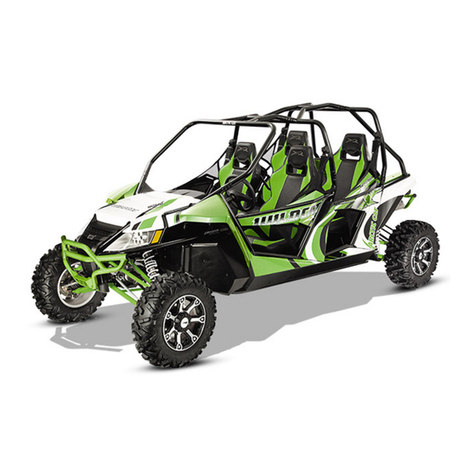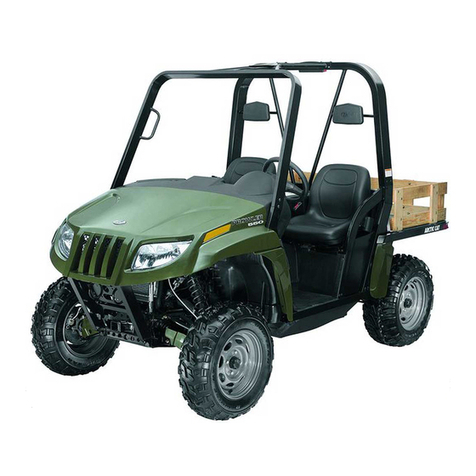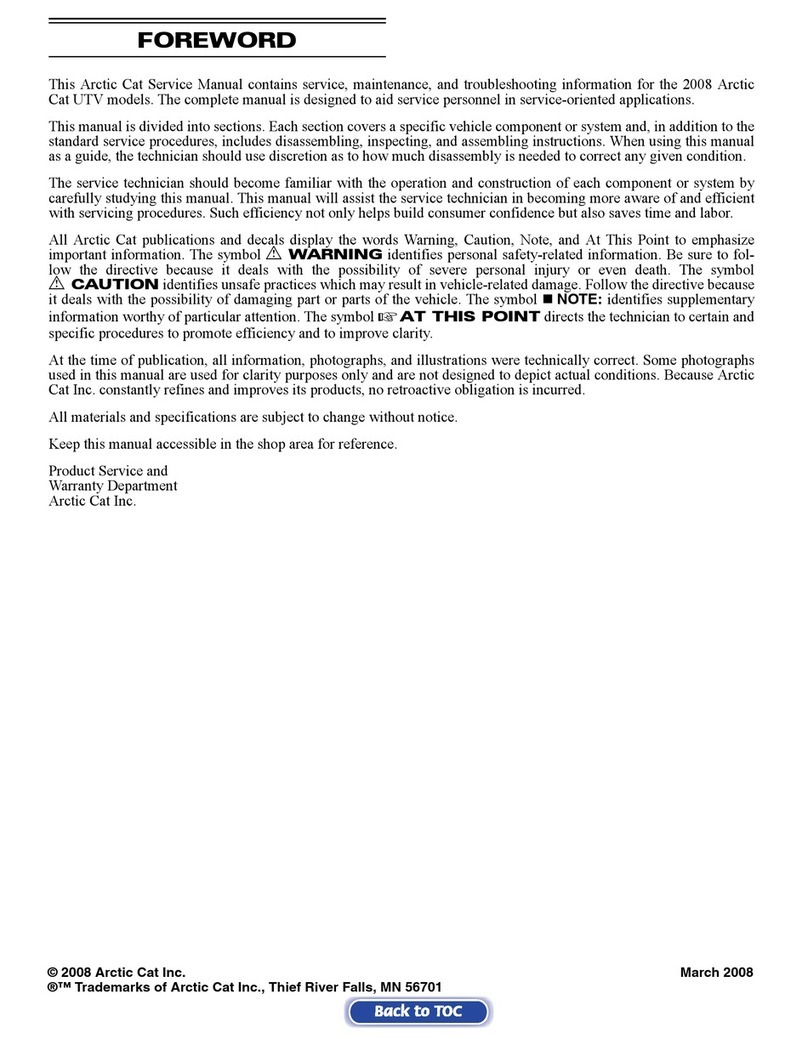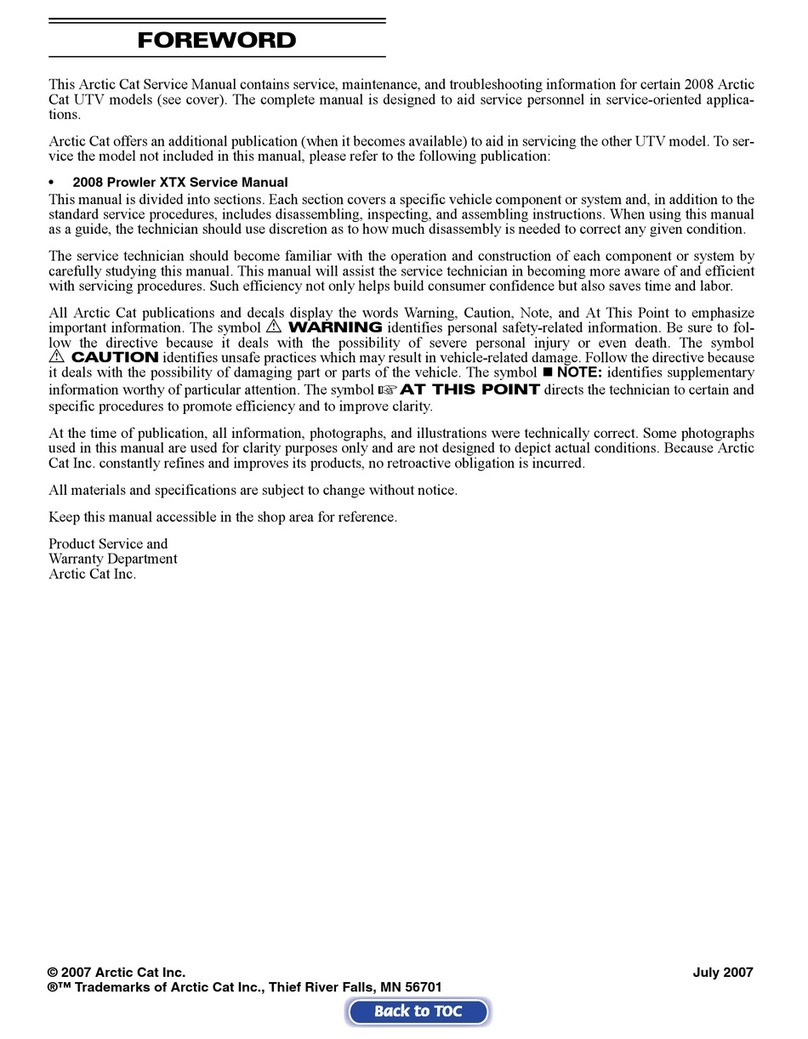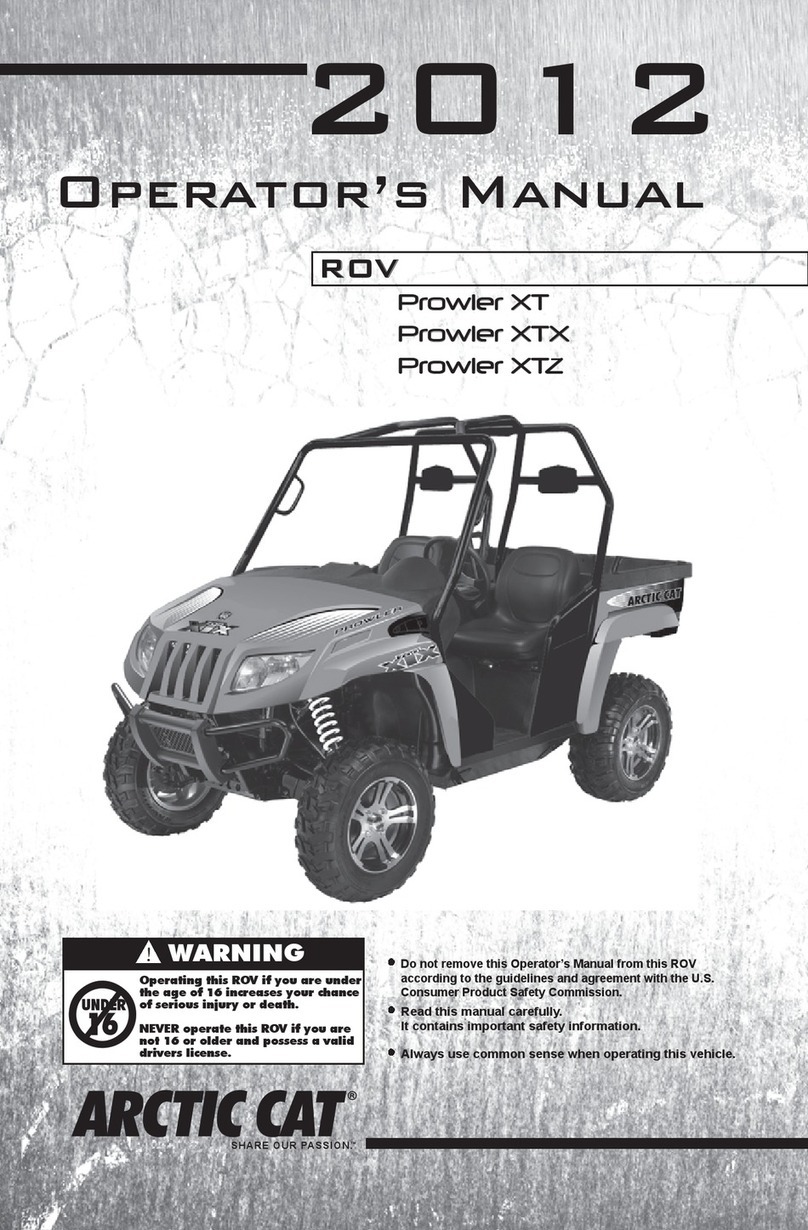
1-4
** w/Red Loctite #271
*** w/Green Loctite #270
Torque Conversions
(ft-lb/N-m)
Break-In Procedure
A new vehicle and an overhauled engine require a
“break-in” period. The first 10 hours (or 200 miles) are
most critical to the life of this vehicle. Proper operation
during this break-in period will help assure maximum life
and performance from the vehicle.
During the first 10 hours (or 200 miles) of operation,
always use less than 1/2 throttle. Varying the engine
RPM during the break-in period allows the components
to “load” (aiding the mating process) and then “unload”
(allowing components to cool). Although it is essential to
place some stress on the engine components during
break-in, care should be taken not to overload the engine
too often. Do not pull a trailer or carry heavy loads dur-
ing the 10-hour break-in period.
When the engine starts, allow it to warm up properly. Idle
the engine several minutes until the engine has reached
normal operating temperature. Do not idle the engine for
excessively long periods of time.
ENGINE/TRANSMISSION - H2
Part Part Bolted To Torque
ft-lb N-m
Clutch Shoe** Crankshaft 221 300
Clutch Cover/Housing
Assembly
Crankcase 8 11
Lower Crankcase Cover
(6 mm)
Crankcase 8 11
Lower Crankcase Cover
(8 mm)
Crankcase 20 27
Crankcase Half Crankcase Half 8 11
Cylinder Head (Cap Screw) Crankcase 38 52
Cylinder Head Nut (6 mm) Cylinder 8 11
Cylinder Head Nut (8 mm) Cylinder 18 24
Valve Cover Cylinder Head 8.5 11.5
Driven Pulley Nut** Driveshaft 80 109
Movable Drive Face Nut** Driveshaft 165 224
Ground Wire Engine 8 11
Magneto Cover Crankcase 8 11
Tappet Cover Valve Cover 9 12
Crankshaft Spacer Crankshaft 28 38
Oil Pump Drive Gear** Crank Balancer Shaft 62 84
Output Yoke Nut** Output Shaft 74 100
Outer Magneto Cover Magneto Cover 8 11
Rotor/Flywheel Nut** Crankshaft 105 143
Cam Sprocket** Camshaft 11 15
CVT Cover Crankcase 8 11
Secondary Drive Gear Nut** Secondary Drive Output
Shaft
74 100
Oil Filter Cover Crankcase 8 11
Speed Sensor Housing Crankcase 8 11
Shift Cam Stopper Crankcase 8 11
Shift Cam Stopper Spring Shift Cam Stopper 8 11
Shift Cam Plate Shift Cam Shaft 8 11
Shifter Housing Crankcase 8 11
Starter Motor Crankcase 8 11
V-Belt Cover Crankcase 8 11
Oil Pump Cover** Crankcase 8 11
Oil Strainer Cap Crankcase 8 11
Stator Coil* Magneto Cover 8.5 11.5
Intake Boot Clamp Intake Boot 30
in.-lb
3.4
Starter One-Way Clutch** Flywheel 26 35
DRIVE TRAIN COMPONENTS
Rear Differential/Gear Case Frame 38 48
Drive Coupler (Front) Drive Flange 40 54
Front Engine Mounting Bracket Frame 45 61
Rear Engine Mounting Bracket Frame 45 61
Engine Mounting Through-Bolt Frame 40 54
Front Differential Frame/Differential Bracket 38 52
Rear Output Flange Rear U-Joint Flange 40 54
Input Shaft Assembly Gear Case Housing 23 31
Pinion Housing Differential Housing 23 31
Thrust Button Gear Case Cover 8 11
Differential Housing Cover*** Differential Housing 23 31
Drive Bevel Gear Nut*** Shaft 87 118
Lock Collar Differential Housing 125 170
Hub Nut Front/Rear Shaft/Axle (min) 200 272
Oil Drain Plug Front Differential - Rear
Drive
45
in.-lb
5
Oil Fill Plug Front Differential - Rear
Drive
16 22
Oil Drain Plug Engine 16 22
Wheel (Aluminum) Hub 80 108
Wheel (Steel) Hub 45 61
Front Input Drive Flange Front U-Joint 20 27
ft-lb N-m ft-lb N-m ft-lb N-m ft-lb N-m
11.4 26 35.4 51 69.4 76 103.4
22.7 27 36.7 52 70.7 77 104.7
34.1 28 38.1 53 72.1 78 106.1
45.4 29 39.4 54 73.4 79 107.4
56.8 30 40.8 55 74.8 80 108.8
68.2 31 42.2 56 76.2 81 110.2
79.5 32 43.5 57 77.5 82 111.5
810.9 33 44.9 58 78.9 83 112.9
912.2 34 46.2 59 80.2 84 114.2
10 13.6 35 47.6 60 81.6 85 115.6
11 15 36 49 61 83 86 117
12 16.3 37 50.3 62 84.3 87 118.3
13 17.7 38 51.7 63 85.7 88 119.7
14 19 39 53 64 87 89 121
15 20.4 40 54.4 65 88.4 90 122.4
16 21.8 41 55.8 66 89.8 91 123.8
17 23.1 42 57.1 67 91.1 92 125.1
18 24.5 43 58.5 68 92.5 93 126.5
19 25.8 44 59.8 69 93.8 94 127.8
20 27.2 45 61.2 70 95.2 95 129.2
21 28.6 46 62.6 71 96.6 96 130.6
22 29.9 47 63.9 72 97.9 97 131.9
23 31.3 48 65.3 73 99.3 98 133.3
24 32.6 49 66.6 74 100.6 99 134.6
25 34 50 68 75 102 100 136

